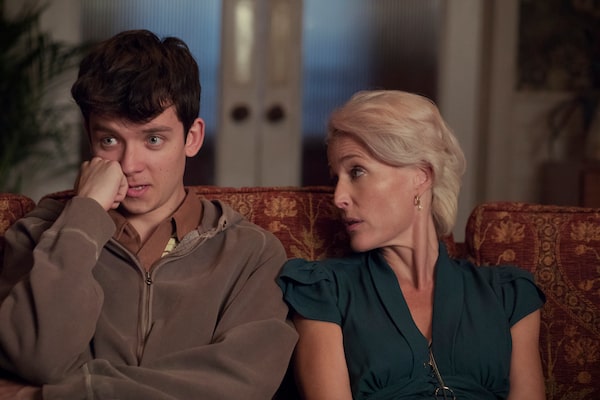
Asa Butterfield, left, and Gillian Anderson in a scene from Sex Education.Sam Taylor/Netflix/The Associated Press
It’s been two years since Sex Education’s third season aired, so those who haven’t had time for a rewatch will need a recap before tucking into its fourth and final outing, which dropped on Netflix on Sept. 21. The show has you covered: A Season 3 recap, delivered by Gillian Anderson’s Jean Milburn, is also now available on the streamer. It’s a great catch-up, but even if you don’t need one it’s worth a watch for the charming perspective shift Anderson makes in its final few phrases.
But I’ll get you up to speed here, too. In Season 3, amateur sex therapist Otis Milburn (Jean’s son, played by Asa Butterfield) has bid farewell to his will-they-won’t-they love interest Maeve (Emma Mackey), who’s flown off to the United States as part of an academic program, while his best friend Eric (Ncuti Gatwa) continues to explore his queerness (paramour Adam, played by Connor Swindells, does the same, though in messier fits and starts). Jean is pregnant, though it’s not clear by whom, and Moordale Secondary School, ground zero for three seasons, is up for sale. Frankly, there’s a whole lot more (and a whole lot more characters); if nothing else, Sex Education has always been soap-operatic in its narrative scope.
Season four opens, after Jean’s summation, on the show’s new setting: Cavendish College, a high-tech academy that’s a start-up in spirit (and style), and is cartoonish in its progressiveness: A tour led by new characters (and school alphas) Roman, Abbi and Aisha includes a silent disco, gender-neutral bathrooms, meditation rooms, outdoor yoga and amateur beekeeping. The tour also eventually includes an introduction to O, who leads her own sex therapy clinic at Cavendish – and provides Otis with of a professional rival. Jean, meanwhile, has given birth to a baby daughter, and is parenting without former flame Jakob (Mikael Persbrandt), who is absent from this season.
Absent, too, is Jakob’s daughter Ola (Patricia Allison), her eccentric partner Lily (Tanya Reynolds), cool-girl Olivia (Bridgerton star Simone Ashley) and her bestie Anwar (Chaneil Kular). Their absences are fulfilled by Cavendish’s new cast of characters, who bring discussions of asexuality, transgenderism and disability to the show’s fore. Unfortunately, Sex Education’s abandonment of some key players and hasty introduction of new ones results in a final season that lacks the emotional punch of its previous three.
In a way, the show here hoists itself up by its own petard. Sex Education is making one last effort at ensuring it is as representative as possible of humanity and human sexuality. It’s laudable – and, frankly, given the amount of ground covered, it’s hard to imagine another show ever doing quite so well in this regard – but in packing its final season so tightly with so many different storylines, neither the established characters nor the new ones (nor, frankly, the ones left behind) are given a fair shake.
It’s a little bite of everything, but in the end not much to chew on. And it’s a shame, too, because Roman, Abbi, Aisha and O are characters worthy of investment, done a disservice by a one-season run.
On the other hand, while its final season doesn’t offer much in the way of catharsis or closure, Sex Education will (or, at least, should) have a legacy of being much more than the sum of its parts. The show has tackled an unthinkable breadth of issues with matter-of-factness, empathy and good humour, without falling to preachiness or platitudes. It presented its various plotlines and the complex identity politics therein with a genuine, clear-cut earnestness. There’s no cheese, no therapy talk (which is sort of a miracle, considering the entire show is centred on a sex therapy practice) and virtually no talking down to its audience – just an at-times striking representation of humanity and true grace.
Any person, of any age, trying to reconcile their personal identity – sexual or otherwise – with a world that has made them feel less than (or worse) will likely find something resonant in Sex Education. They’ll find, too, a lot of sex, presented unflinchingly and without reverence, but as a sort of unavoidable part of life.
Historically, marginalized individuals have seen themselves represented in pop culture through stories that focus on trauma and struggle. Sex Education’s narratives and settings – be it the dilapidated bathroom stall of Otis’s amateur sex therapy clinic, the back of a bus where seven girls gather to show support for a sex-assault survivor, or the town hall converted into a queer disco-ball-lit dance night – use trauma and struggle only as a starting point to navigate toward acceptance.
So if its primarily legacy is the sheer breadth of its representation, Sex Education’s secondary impact could be drawing a functional blueprint for how to realistically, unsentimentally portray healing – and hope.